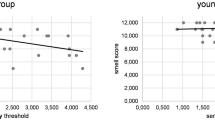Abstract
Physiological anorexia, decreased dietary variation, and weight loss associated with poor health are common conditions in the elderly population, with changes in chemosensory perception as important contributing causes. The present study of age-related taste loss aimed to investigate the question whether this loss is generalised and unspecific, or whether it exhibits differences in relation to certain tastants and/or differences in the topographical distribution of age-related loss. Impregnated “taste strips” with four concentrations of each of the tastants sucrose, NaCl, quinine-hydrochloride, and citric acid were applied on the tip, midlateral and posteromedial tongue regions to be identified as either sweet, salty, bitter, or sour by 30 young and 26 elderly adults. The results showed more pronounced age-related loss in identification for citric acid and quinine-hydrochloride than for sucrose and NaCl at both the tip and midlateral regions, but not at the posteromedial region where both age groups performed close to chance level. These findings may have implications for food preferences, and thus, the diets of elderly people.


Similar content being viewed by others
References
Brown EL (1976) Factors influencing food choices in the elderly. Geriatrics 31:89–92
Fanelli MT, Stevenhagen KJ (1985) Characterizing consumption patterns by food frequency methods: core foods and variety of foods in diets of older Americans. J Am Diet Assoc 85:1570–1576
Wilson MMG, Morley JE (2003) Invited review: aging and energy balance. J Appl Physiol 95:1728–1736
Schiffman SS (1997) Taste and smell losses in normal aging and disease. J Am Med Assoc 29:1357–1362
Arey LB, Tremaine MJ, Monzingo FL (1935) The numerical and topographic relations to taste buds to human circumvallate papillae through the life span. Anat Rec 64:9–25
Moses SW et al (1967) A clinical, genetic and biochemical study of familial dysautonomia in Israel. Israel J Med Sci 3:358–371
Mattes RD, Cowart BJ (1994) Dietary assessment of patients with chemosensory disorders. J Am Diet Assoc 94:50–56
Wysocki CJ, Pelchat ML (1993) The effects of aging on the human sense of smell and its relationship to food choice. Crit Rev Food Sci Nutr 33:63–82
Koskinen S, Nenonen A, Tuorila H (2005) Intakes of cold cuts in the elderly are predicted by olfaction and mood, but not by flavor type or intensity of the products. Physiol Behav 85:314–323
Schiffman SS, Miletic ID (1999) Effect of taste and smell on secretion rate of salivary IgA in elderly and young persons. J Nutr Health Aging 3:158–164
Schiffman SS (1998) Sensory enhancement of foods for the elderly with monosodium glutamate and flavors. Food Rev Int 14:321–333
Schiffman SS, Warwick ZS (1988) Flavor enhancement of foods for the elderly can reverse anorexia. Neurobiol Aging 9:24–26
Cooper RM, Bilash I, Zubek JP (1959) The effect of age on taste sensitivity. J Gerontol 14:56–58
Hinchcliffe R (1958) Clinical quantitative gustometry. Acta Otolaryngol 49:453–466
Cowart BJ (1989) Relationships between taste and smell across the adult life span. Ann NY Acad Sci 561: 39–55
Weiffenbach JM, Baum BJ, Burghauser R (1982) Taste thresholds: quality specific variation with human aging. J Gerontol 37:372–377
Enns MP and Hornung DE (1988) Comparisons of the estimates of smell, taste and overall intensity in young and elderly people. Chem Senses
Murphy C, Gilmore MM (1989) Quality-specific effects of aging on the human taste system. Percept Psychophys 45:121–128
Gilmore MM, Murphy C (1989) Aging is associated with increased Weber ratios for caffeine, but not for sucrose. Percept Psychophys 46:555–559
Nordin S et al (2003) Age-associated increases in intensity discrimination for taste. Exp Aging Res 29:371–381
Miller IJJ (1995) Anatomy of the peripheral taste system. In: Doty RL (ed) Handbook of olfaction and gustation. Marcel Dekker, New York, pp 521–547
Yamaguchi K et al (2001) Age-related alteration in taste bud distribution in the common marmoset. Chem Senses 26:1–6
Mueller C et al (2003) Quantitative assessment of gustatory function in a clinical context using impregnated “taste strips”. Rhinology 41:2–6
Ahne G et al (2000) Assessment of gustatory function by means of tasting tablets. Laryngoscope 110:1396–1401
Hummel T, Erras A, Kobal G (1997) A new test for the screening of taste function. Rhinology 35:146–148
Gilbertson TA, Damak S, Margolskee RF (2000) The molecular physiology of taste transduction. Curr Opin Neurobiol 10:519–527
Scott K (2004) The sweet and the bitter of mammalian taste. Curr Opin Neurobiol 14:423–427
Englehardt R et al (1993) Taste performance of the anterior human tongue varies with fungiform taste bud density. Chem Senses 18:550
Reedy FE et al (1993) Relationships among papillae, taste pores, and 6-n-propylthiouracil (PROP) supra-threshold taste intensity. Chem Senses 18:618
Mochizuki Y (1937) An observation of the numerical and topographical relation of taste buds to circumvallate papillae of Japanese. Okajimas Folia Anat Jpn 15:595–608
Mochizuki Y (1939) Studies of the papilla foliate of Japanese. Okajimas Folia Anat Jpn 18:355–369
Arvidson K, Friberg U (1980) Human taste: response and taste bud number in fungiform papillae. Science 209:807–808
Miller IJJ (1988) Human taste bud density across adult age groups. J Gerontol Biol Sci 43A:26–30
Bartoshuk LM (1988) Clinical psychophysics of taste. Gerodontics 4:249–255
Acknowledgments
This research was supported by grants from the Swedish ENT Research Fund. We are thankful to Stefan Kallert for producing the taste strips used in this study.
Author information
Authors and Affiliations
Corresponding author
Rights and permissions
About this article
Cite this article
Nordin, S., Brämerson, A., Bringlöv, E. et al. Substance and tongue-region specific loss in basic taste-quality identification in elderly adults. Eur Arch Otorhinolaryngol 264, 285–289 (2007). https://doi.org/10.1007/s00405-006-0169-9
Received:
Accepted:
Published:
Issue Date:
DOI: https://doi.org/10.1007/s00405-006-0169-9




